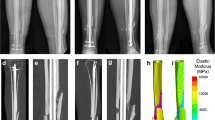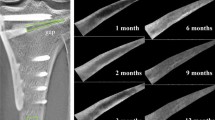Abstract
One of the greatest challenges of limb lengthening and deformity correction is deciding when the bone has healed enough to remove the external fixator. Standard radiography is the most common imaging method used to assess bone healing after distraction osteogenesis because it is widely available, cheap, and relatively safe. However, other imaging technologies and methods are being investigated that will help quantify bone healing after distraction osteogenesis, providing an objective method for deciding when it is appropriate to remove an external fixator. This review will examine the latest techniques used to assess bone healing after distraction osteogenesis including dual-energy X-ray absorptiometry scans, ultrasound, quantitative computed tomography, and digital radiography (X-ray). Recommendations for clinical practice will be outlined.


Similar content being viewed by others
References
Codivilla A (1994) On the means of lengthening, in the lower limbs, the muscles and tissues which are shortened through deformity. 1904. Clin. Orthop. Relat. Res 301:4–9
Bertram C, Nielander KH, Konig DP (1999) Pioneers in the lengthening of the extremities. Chirurg 70 no. 11, 1374–1378
Birch JG, Samchukov ML (2004) Use of the Ilizarov method to correct lower limb deformities in children and adolescents. J. Am. Acad. Orthop. Surg. 12 no. 3, 144–154
Fragomen AT, Rozbruch SR (2007) The mechanics of external fixation. HSS J. 3 no. 1, 13–29
Marsh DR, Shah S, Elliott J, Kurdy N (1997) The Ilizarov method in nonunion, malunion and infection of fractures. J. Bone Jt. Surg. Br. 79 no. 2, 273–279
Paley D, Herzenberg JE, Paremain G, Bhave A (1997) Femoral lengthening over an intramedullary nail. A matched-case comparison with Ilizarov femoral lengthening. J. Bone Jt. Surg. Am. 79 no. 10, 1464–1480
Velazquez RJ, Bell DF, Armstrong PF, Babyn P, Tibshirani R (1993) Complications of use of the Ilizarov technique in the correction of limb deformities in children. J. Bone Jt. Surg. Am 75 no. 8, 1148–1156
Cattermole HC, Cook JE, Fordham JN, Muckle DS, Cunningham JL (1997) Bone mineral changes during tibial fracture healing. Clin. Orthop. Relat. Res 339:190–196
Garcia-Cimbrelo E, Olsen B, Ruiz-Yague M, Fernandez-Baillo N, Munuera-Martinez L (1992) Ilizarov technique. Results and difficulties. Clin. Orthop. Relat. Res. 283:116–123
Eldridge JC, Bell DF (1991) Problems with substantial limb lengthening. Orthop. Clin. North Am. 22 no. 4, 625–631
Ghoneem HF, Wright JG, Cole WG, Rang M (1996) The Ilizarov method for correction of complex deformities. Psychological and functional outcomes. J. Bone Jt. Surg. Am. 78 no. 10, 1480–1485
Ilizarov GA (1990) Clinical application of the tension-stress effect for limb lengthening. Clin. Orthop. Relat. Res. 250:8–26
Rozbruch SR, Kleinman D, Fragomen AT, Ilizarov S (2008) Limb lengthening and then insertion of an intramedullary nail: a case-matched comparison. Clin. Orthop. Relat. Res. 466:2923–2932
Dinah AF (2004) Predicting duration of Ilizarov frame treatment for tibial lengthening. Bone 34 no. 5, 845–848
Fischgrund J, Paley D, Suter C (1994) Variables affecting time to bone healing during limb lengthening. Clin. Orthop. Relat. Res. 301:31–37
Anand A, Feldman DS, Patel RJ, Lehman WB, Bosse HJvan, Badra MI, Sala DA (2006) Interobserver and intraobserver reliability of radiographic evidence of bone healing at osteotomy sites. J. Pediatr. Orthop. B. 15 no. 4, 271–272
Starr KA, Fillman R, Raney EM (2004) Reliability of radiographic assessment of distraction osteogenesis site. J. Pediatr. Orthop. 24 no. 1, 26–29
Dahl MT, Gulli B, Berg T (1994) Complications of limb lengthening. A learning curve. Clin. Orthop. Relat. Res. 301:10–18
Danziger MB, Kumar A, DeWeese J (1995) Fractures after femoral lengthening using the Ilizarov method. J. Pediatr. Orthop. 15 no. 2, 220–223
Simpson AH, Kenwright J (2000) Fracture after distraction osteogenesis. J. Bone Jt. Surg. Br. 82 no. 5, 659–665
Aquerreta JD, Forriol F, Canadell J (1994) Complications of bone lengthening. Int. Orthop. 18 no. 5, 299–303
Forriol F, Iglesias A, Arias M, Aquerreta D, Canadell J (1999) Relationship between radiologic morphology of the bone lengthening formation and its complications. J. Pediatr. Orthop. B. 8 no. 4, 292–298
Dwyer JS, Owen PJ, Evans GA, Kuiper JH, Richardson JB (1996) Stiffness measurements to assess healing during leg lengthening. A preliminary report. J. Bone Jt. Surg. Br. 78 no. 2, 286–289
Richardson JB, Cunningham JL, Goodship AE, O’Connor BT, Kenwright J (1994) Measuring stiffness can define healing of tibial fractures. J. Bone Jt. Surg. Br. 76 no. 3, 389–394
Reichel H, Lebek S, Alter C, Hein W (1998) Biomechanical and densitometric bone properties after callus distraction in sheep. Clin. Orthop. Relat. Res. 357:237–246
Hamanishi C, Yasuwaki Y, Kikuchi H, Tanaka S, Tamura K (1992) Classification of the callus in limb lengthening. Radiographic study of 35 limbs. Acta Orthop. Scand. 63 no. 4, 430–433
Tselentakis G, Owen PJ, Richardson JB, Kuiper JH, Haddaway MJ, Dwyer JS, Evans GA (2001) Fracture stiffness in callotasis determined by dual-energy X-ray absorptiometry scanning. J. Pediatr. Orthop. B. 10 no. 3, 248–254
Chotel F, Braillon P, Sailhan F, Gadeyne S, Gellon JO, Panczer G, Pedrini C, Berard J (2008) Bone stiffness in children: Part II. Objectives criteria for children to assess healing during leg lengthening. J. Pediatr. Orthop 28 no. 5, 538–543
Eyres KS, Bell MJ, Kanis JA (1993) Methods of assessing new bone formation during limb lengthening. Ultrasonography, dual energy X-ray absorptiometry and radiography compared. J. Bone Jt. Surg. Br. 75 no. 3, 358–364
Eyres KS, Bell MJ, Kanis JA (1993) New bone formation during leg lengthening: evaluated by dual energy X-ray absorptiometry. J. Bone Jt. Surg. Br. 75 no. 1, 96–106
Maffulli N, Cheng JC, Sher A, Lam TP (1997) Dual-energy X-ray absorptiometry predicts bone formation in lower limb callotasis lengthening. Ann. R. Coll. Surg. Engl. 79 no. 4, 250–256
Reiter A, Sabo D, Pfeil J, Cotta H (1997) Quantitative assessment of callus distraction using dual energy X-ray absorptiometry. Int. Orthop. 21 no. 1, 35–40
Saran N, Hamdy RC (2008) DEXA as a predictor of fixator removal in distraction osteogenesis. Clin. Orthop. Relat. Res. 466:2955–2961
Braillon P, Chotel F, Berard J (2008) Limb lengthening: contribution of dual energy X-ray absorptiometry. J. Musculoskelet. Neuronal. Interact. 8 no. 1, 32
Young JW, Kostrubiak IS, Resnik CS, Paley D (1990) Sonographic evaluation of bone production at the distraction site in Ilizarov limb-lengthening procedures. AJR. Am. J. Roentgenol. 154 no. 1, 125–128
Bail HJ, Kolbeck S, Krummrey G, Weiler A, Windhagen HJ, Hennies K, Raun K, Raschke MJ (2002) Ultrasound can predict regenerate stiffness in distraction osteogenesis. Clin. Orthop. Relat. Res. 404:362–367
Markel MD, Chao EY (1993) Noninvasive monitoring techniques for quantitative description of callus mineral content and mechanical properties. Clin. Orthop. Relat. Res. 293:37–45
Markel MD, Wikenheiser MA, Morin RL, Lewallen DG, Chao EY (1990) Quantification of bone healing. Comparison of QCT, SPA, MRI, and DEXA in dog osteotomies. Acta Orthop. Scand. 61 no. 6, 487–498
Markel MD, Morin RL, Wikenheiser MA, Robb RA, Chao EY (1991) Multiplanar quantitative computed tomography for bone mineral analysis in dogs. Am. J. Vet. Res. 52 no. 9, 1479–1483
Markel MD, Morin RL, Wikenheiser MA, Lewallen DG, Chao EY (1991) Quantitative CT for the evaluation of bone healing. Calcif. Tissue Int. 49 no. 6, 427–432
Harp JH, Aronson J, Hollis M (1994) Noninvasive determination of bone stiffness for distraction osteogenesis by quantitative computed tomography scans. Clin. Orthop. Relat. Res. 301:42–48
Aronson J, Shin HD (2003) Imaging techniques for bone regenerate analysis during distraction osteogenesis. J. Pediatr. Orthop. 23 no. 4, 550–560
Skaggs DL, Leet AI, Money MD, Shaw BA, Hale JM, Tolo VT (1999) Secondary fractures associated with external fixation in pediatric femur fractures. J. Pediatr. Orthop. 19 no. 5, 582–586
Kolbeck S, Bail H, Weiler A, Windhagen H, Haas N, Raschke M (1999) Digital radiography. A predictor of regenerate bone stiffness in distraction osteogenesis. Clin. Orthop. Relat. Res. 366:221–228
Hazra S, Song HR, Biswal S, Lee SH, Lee SH, Jang KM, Modi HN (2008) Quantitative assessment of mineralization in distraction osteogenesis. Skelet. Radiol. 37 no. 9, 843–847
Author information
Authors and Affiliations
Corresponding author
Additional information
Each author certifies that he or she has no commercial associations (e.g., consultancies, stock ownership, equity interest, patent/licensing arrangements, etc.) that might pose a conflict of interest in connection with the submitted article.
Rights and permissions
About this article
Cite this article
Babatunde, O.M., Fragomen, A.T. & Rozbruch, S.R. Noninvasive Quantitative Assessment of Bone Healing After Distraction Osteogenesis. HSS Jrnl 6, 71–78 (2010). https://doi.org/10.1007/s11420-009-9130-y
Received:
Accepted:
Published:
Issue Date:
DOI: https://doi.org/10.1007/s11420-009-9130-y




